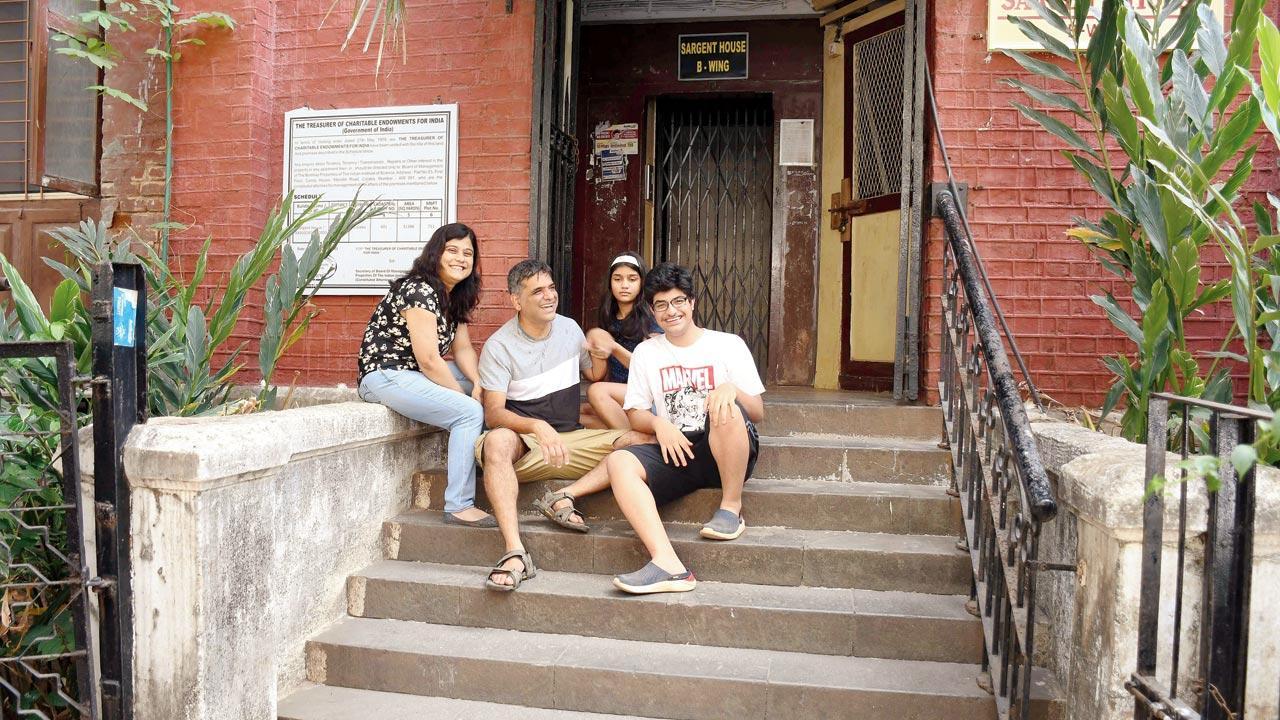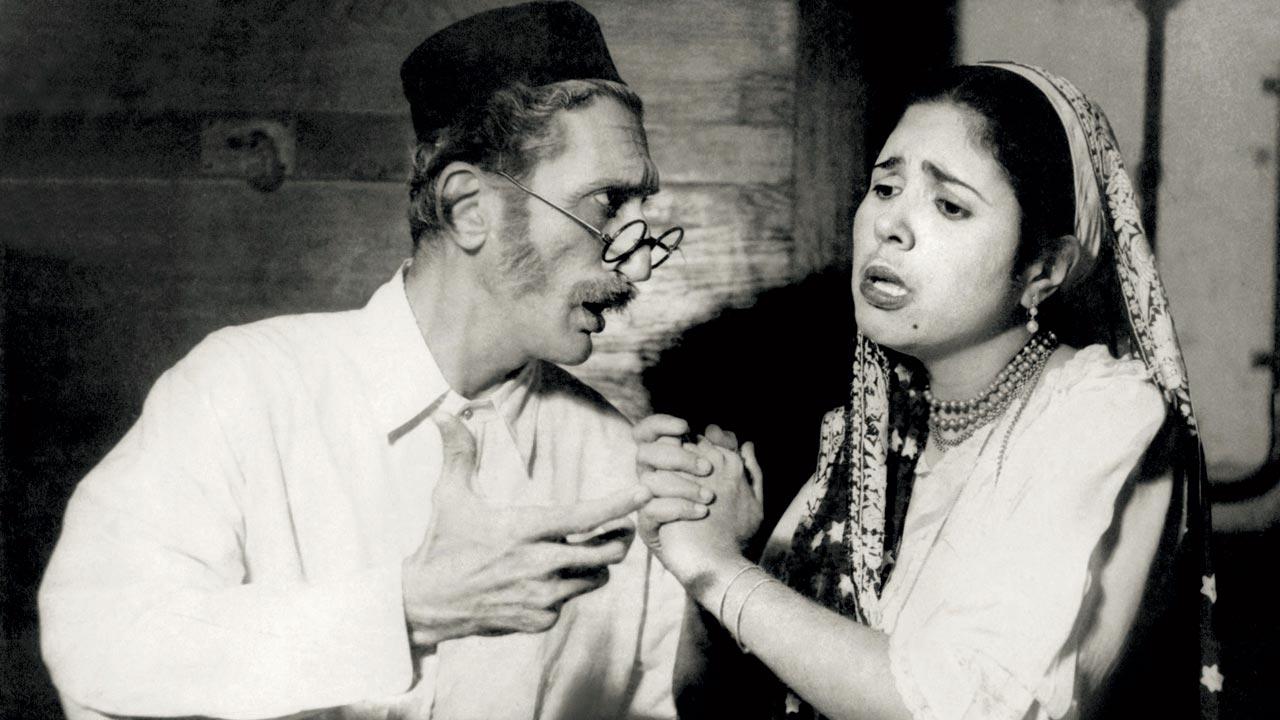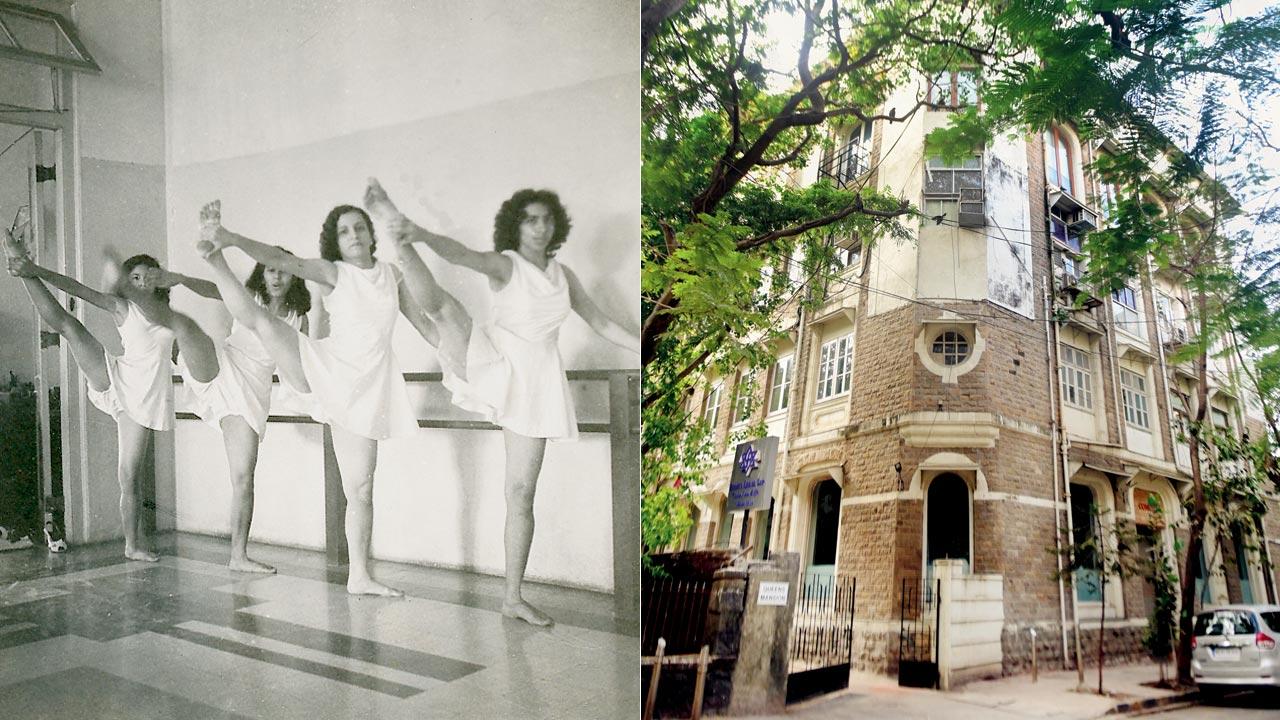Artists, dancers, poets, musicians and scientists have warmed the walls of Sargent House in Colaba and Queens Mansion at Fort since 1902

Physicist Shiraz Minwalla, wife Ananya and children Chinar and Spandan, outside their Sargent House home, Colaba. Pic/Ashish Raje
 The contrast is striking. On a road renamed in utilitarian fashion—after the frozen products giant JA Allana—stands Sargent House, imbued with keen artistic fervour.
The contrast is striking. On a road renamed in utilitarian fashion—after the frozen products giant JA Allana—stands Sargent House, imbued with keen artistic fervour.
Once largely populated by Anglo-Indians and Europeans, Allana Road, off Colaba Causeway, was earlier the Bombay Port Trust-erected Barrow Road, acknowledging HW Barrow, Secretary of the Municipal Corporation.
ADVERTISEMENT
On a street whose architecture infuses enough French elements for buildings to remind tourists of New Orleans, 1902-constructed Sargent House twins Jenkins House on parallel Henry Road in appearance. Named for a Bombay Municipal Councillor, it is among six properties in the vicinity, acquired by the Indian Institute of Science. Jamsetjee Tata intended that the rent they fetched contribute to the institute’s development.
 Singing star Dinshah Daji with Piloo Wadia in Hasta Gher Vasta. Pic courtesy/Meher Marfatia, Laughter in the House: 20th-Century Parsi Theatre
Singing star Dinshah Daji with Piloo Wadia in Hasta Gher Vasta. Pic courtesy/Meher Marfatia, Laughter in the House: 20th-Century Parsi Theatre
Engineer Ismail Kurwa’s grandfather from Surat settled in Sargent House after trading spice in Singapore. The family discovered entertaining neighbours, such as Raj relic Harry Lyttler. “Harry narrated his experiences fighting in Mesopotamia during World War I,” says Kurwa, who learnt to play the flute from Lyttler, a Manchester Symphony Orchestra flautist. Lesson done, the tutor produced a Scotch bottle that he and his pupil quaffed on the verandah.
A purist pianist as well, Lyttler rasped sharp instructions rectifying false notes from his bed even shortly before passing away. Shera Lalljee, his British passport-holder wife, hosted exclusive brunches for an expat society, The Elizabethans.
As a child, physicist Shiraz Minwalla visited his grandmother’s sister, Masi Zuleikha, who was Ismail’s mother, in the third floor flat where the Kurwas live. “The staircases were dark and scary. We wondered if the liftman would be on duty, rather than at lunch or chai break, so that we could use the lift.” Now in the TIFR flat which has housed the likes of Raja Ramanna and Atul Gurtu, Minwalla says, “Our garden is exceptionally pleasant, with room to play cricket with my son [the full variety with season ball, gloves and pads]. We are lucky to directly access it through our balcony. The building’s high ceilings and thick walls keep our ground floor flat cool.”
 Dancer Hilde Holger’s pupils practising in her 1940s studio. Pic courtesy/Hilde Holger Archive (c) 2001 Primavera Boman-Behram; (right) Facade of Queens Mansion on Prescott Road in Fort. Pic/Bipin Kokate
Dancer Hilde Holger’s pupils practising in her 1940s studio. Pic courtesy/Hilde Holger Archive (c) 2001 Primavera Boman-Behram; (right) Facade of Queens Mansion on Prescott Road in Fort. Pic/Bipin Kokate
Children from the lane came to climb Sargent House’s sitafal tree, avoiding its malodorous java olive. A lime tree she planted in this garden, shaded by a whispering gulmohar, was actress Leela Naidu’s joy. Her parents were nuclear scientist Ramaiah Naidu, who worked with Nobel Prize-winner Madame Curie, and Marthe Mange, an Irish Indologist of Swiss-French origin. Crowned Miss India 1954, Naidu was surrealist Salvador Dali’s muse, filmmaker Jean Renoir’s protege, actress Ingrid Bergman’s shopping partner in Paris and would-be heroine of Dr Zhivago (nearly bagging Geraldine Chaplin’s role, had her Madrid flight for David Lean’s audition not been critically delayed).
The woman Vogue voted one of the world’s 10 most beautiful, married hotelier Tikki Oberoi and then poet Dom Moraes. She entertained Salman Rushdie and Bianca Jagger with flair at Sargent House. Lonely later years left her in the company of trusted aide Selvam and Quartpatch the white cat with four black splotches.
Mixed blooded like Naidu, another resident, Jalabala (Jili) Vaidya, went on to become the first Indian woman on Broadway. The actress was born to English-Italian concert singer Marjorie Frank-Keyes and freedom fighter journalist Suresh Vaidya.
Rashna Press, now in Dubai, grew up in the apartment currently with her family’s fourth generation. “It has the typical charm of an old Bombay building, with wooden beams and teak doors. A front garden and high plinth afforded privacy. The house had a constant flow of visitors. It was rare when someone didn’t drop in to spend the evening. Mrs Gidwani from Number 3 did at 4 sharp every afternoon for a coffee chat. Our ground floor was convenient, my mother was the go-to. People left their shopping with us, their mail and keys to the electric meter cupboard.”
Weaving hairpieces for actors, cancer patients and fast balding, “super-stressed young people”, Rajan and Ashok Bhawnani of Monarch Wigs ensure clients leave their premises with springy confidence. Twenty years after arriving from Karachi in 1949, the brothers decided to pamper thinning gents’ pates. Across the landing lived Alex Correa, drummer for his swing king brother Mickey’s popular band at the Taj.
Sargent House shone, kaleidoscopic, with a host of personalities boasting diverse interests. National cricket was represented here by batsman Rusi Modi and Parsi theatre by comedian Dinshah Daji. The singing star, whose day job was that of a BEST grain shop officer, was fond of ordering Chinese food from Frederick’s behind Regal Cinema.
The Kumars came around 1957, having trod the Partition path. Finance consultant Rohit Kumar’s father Bir Sen Kumar circuited from Lahore to Delhi to Bangalore to Bombay. From their top-floor flat they saw the Taj, which Sargent House predates by six months. A decade before, a brave immigrant roughed out the longer refugee route to this address. Rohit Kumar remembers, “Ms Primakoff travelled seven years from Russia to India, half on foot, half train. She made a living by teaching naval officers her language.”
A more famous emigre reinvented life a kilometre north, in Queens Mansion on Prescott Road, Fort. Hilde Holger fled Vienna—25 members of her Jewish family, including mother and sister, were gassed to death in Auschwitz—at a day’s notice. Docking in Bombay, the expressionist artiste, choreographer and pioneer of integrated dance therapy for handicapped children, ran the School of Art for Modern Movement from 1941. This was likely in the third-storey space where Jnanapravaha curates Indian culture courses.
From London, Holger’s daughter Primavera Boman-Behram shares her mother’s note: “My start was not easy, the only positive being my large studio near Flora Fountain in a building which had been a hotel… The lower flat office was occupied by a nice Parsee gentleman who loved Western music and always asked for a special tune to be repeated in my classes.”
Juxtaposed with Holger’s journey, the British military’s Field Intelligence Unit operated from Queens Mansion through the war years. Two stairways—one sprawling wide, one Alice in Wonderland-narrow—have led up the premises since 1902-04 when this colonial stone building, with solid steel columns, semi-circular arches and natural chowk ventilation, was leased to Robert Laidlaw of Whiteway and Laidlaw emporium.
A window arch streams sunshine, pleasantly punctuating white surfaces intrinsic to exhibition spaces. It forms the crux of conversation with architect Rajiv Saini, who adapted heritage exteriors to contemporary requirements. Kekoo and Khorshed Gandhy’s Gallery Chemould, renamed Chemould Prescott Road, shifted to Queens Mansion from Jehangir Art Gallery 15 years ago.
Commissioned by their daughter Shireen to design the interiors, Saini says, “A rhythm of street-overlooking windows presents the primary facade. Wanting to respect the building’s bare bones, yet showing only certain traces of its history, I retained one wall with the old brickwork exposed. Though familiar with traditional expectations of white in galleries, I consciously kept coloured the offices, storage and restroom areas.”
Advocate Erach Kotwal points out that his south wing office maintains the building’s sole original layout. In a room ringed by 9-inch-thick walls lined with legal tomes, he says, “With a prime location just outside the Fort precinct of the British period, Queens Mansion had 12 residences, allotted a servants’ quarter each on the terrace.” That arrangement for a dozen Englishmen-employed chefs and chauffeurs is presently crammed with a warren of almost twice as many kholis.
Facing Kotwal, Kamal Hadker set up Sterling Engineering Consultancy in 1978. Six years prior, her grandfather NB Hadker had launched Hadker Prabhu and Associates, at the spot where Lillian Bonall’s dance academy was. Its wooden floor is still intact.
The Meeting Room on the first floor has been active for Easter seasons all the way from 1938 when Brother Handley Bird spread the Gospel here. “Our group hails humanity saved by Jesus’ return,” says KV Simon, an elder of The Christian Brethren Assembly, which invites Sunday public gatherings.
It is engaging to profile the preachers and healers, dancers and painters, designers and lawyers inhabiting Queens Mansion. The birdman on its mosaic tiled terrace is especially fascinating. Pradeep D’Souza rescues injured birds and releases them healed. Leading me to his door are the kind, wizened ladies of Queens Mitra Mandal, as they refer to themselves.
“Sit on her shoulder, Mango,” a little yellow parrot hears. I squirm from the first-tickly-then-prickly beak nibbling my linen shirt. Kiwi, the green parrot, messily feasts on milk bread and corn. Their species is hardly alone. Ducking under low-hung lines of washing dried in the hot April sun, I see single-eyed, broken-legged egrets, owls, kites, mynas, bulbuls and seagulls. They huddle, hobble, skip or swoop, depending on individual vulnerability and recovery rates.
D’Souza picks up avian “patients” pulley-style from big baskets people place them in beside the building entrance. In the blur of hundreds of feathered wings, some quails hop into view. They were found wounded along the Khareghat Colony thickets on Malabar Hill.
His sister-in-law Joanita walks me down Queens Mansion’s dizzying spiral stairs, clutching a midday meal packet for a pooch at Sleight of Hand, the animal-friendly cafe opposite, on the verge of closure. “We will miss him,” she sighs. “But this is that city which usually cares for all creatures.”
This is that moment when much feels right with the world.
Author-publisher Meher Marfatia writes fortnightly on everything that makes her love Mumbai and adore Bombay. You can reach her at meher.marfatia@mid-day.com/www.meher marfatia.com
 Subscribe today by clicking the link and stay updated with the latest news!" Click here!
Subscribe today by clicking the link and stay updated with the latest news!" Click here!








